![]() Videos Latest work Sonja's c.v. Arranged by Medium A tour via thumbnail images
Videos Latest work Sonja's c.v. Arranged by Medium A tour via thumbnail images
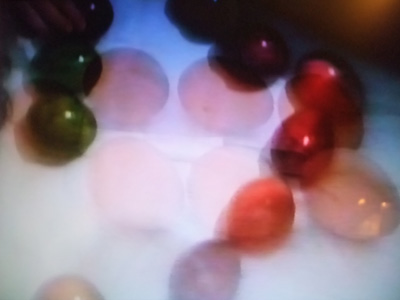
Still "Wrapping for a marginal citizen"
1994, 13 minutes, 26 seconds
Music: Michel Verheecke (Belgium),
Voice: Sonja van Kerkhoff, Actors: 6 children.
English with a few New Zealand Māori words.
More about this video
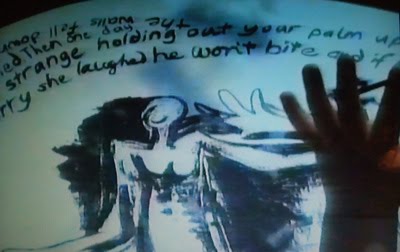
Still "Wrapping for a marginal citizen,"
1994, 13 minutes, 26 seconds
Inspired by the 1990 film, "Buster's Bedroom" by Rebecca Horn
whose sculpture features as props, this still shows my sculpture Bijzetafel.
In 1990 while studying for a masters equivalent at the Maastricht School of Visual Arts (De Academie Beeldende Kunsten Maastricht, The Netherlands) I was on the hunt for a space to store my things because while away from art school for three days giving birth to my eldest son, the art tutors took over my studio as their tea room. My things were left lying in the corridor.
While searching around the art school for unused rooms, closets, and drawers, I found a cupboard of video equipment.
A year later I heard that a guest teacher was teaching design students basic editing and I asked to be allowed to join. That would be too complicated for the administration because I was in the art department, not in design, and so this tutor gave me instructions and left me to it. And he helped me many times when I got stuck.
Two years later I traded teaching design students how to work with equipment for access to the equipment and studio, and won the 1995 provincial documentary film prize with my 13 minute short film, Wrapping for a Marginal Citizen.
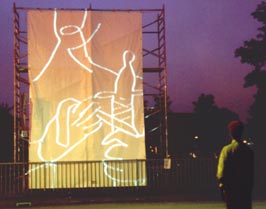
Projection of Essences & Particularities, 1994,
6 min, in a north Leiden city park as part of the
2001 TamTam multicultural festival.
Music: Evren Celimli (USA). Text: English.
So in a sense I am self taught learning from the opportunity of attending diverse video festivals in the Netherlands, which often offered free master classes on technique. Once I had a bit of knowledge I found filmmakers very willing to engage with me which in turn helped me to broaden my skillset and conceptual approach to the medium.
I find the medium of the moving image a powerful means for not only experimentation for engagement on various levels but very enjoyable because of the added possibilities of motion (time) and sound. I use this medium to experiment with narrative and rhythm as well as making more documentary-oriented films. Usually I make videos where the visuals, sounds and text (narrative) are aimed to engage the viewer primarily as an aesthetic experience.
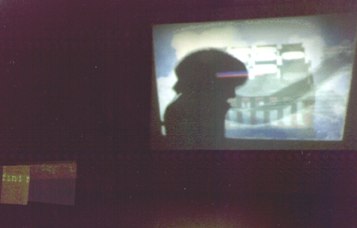
Detail: Making Salt, 1998, at ISEA '98
(InterSociety for Electronic Arts) symposium, Manchester, U.K.
View of the back projection with just two of the five panels.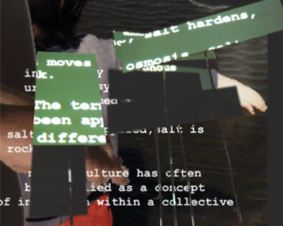
Detail: Making Salt performance, 1998
In 1998 I was invited to make a 7 minute something for InterSociety for Electronic Arts (ISEA) symposium in Manchester, U.K. The video/interactive performance Making Salt was a response to their theme “Terror.”
I often work collaboratively and invited Gaudi Hoedaya and Sarah Buist to be part of this. For us the terror of the information age, meant the shapeless super-abundance of information itself. Our presention-performance was a metaphor for sifting information.
The performance in the lecture theatre started in darkness with Gaudi and Sarah ushering everyone sit together behind where I was seated midway down, so they could o pass the salt grains handed to them, palm to palm.
The 6 minute video, Grains of Salt, played on a large screeen while I typed texts which appeared in the air above onto small screens that interfered with the video projection at the back of theatre. These texts faded when other texts were typed over them.
Our soundscape were the sounds of suprise and laughter from the audience when they were asked to pass the salt.
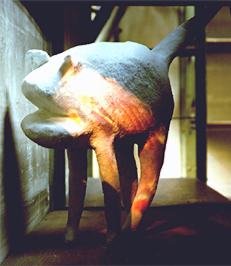
Grains of Salt, 1999,
video projection on the
middle floor of the
The continuously expanding space
installation.
A year later I curated a show in the 19th century archival building of the Hague where the same video, was now projected onto a sculpture in the multi-storey installation, The continuously expanding space, with new a soundscape of texts whispered in Dutch and English.
Watch a 1 min 36 sec excerpt on vimeo.
Making videos has also been a way for me to combine music (by friends who are musicians) with my visual work. An example is the video Transit in a green landscape with music by Mark Laurent first shown on a small screen outdoors at SPLORE 2012 as part of Trude Lane's kilometre long intervention, A Walk in Deep Time.
I also use the medium of the moving image in combination with other media. My first video installation was Ablutions (1995) which was a recording of a performance, presented as a projection between 4 pillars.
The 6 minute video edit of a performance shows variations to indicate that this is a process rather than a looped sequence. This distinction is important in this work because the repeated act is to evoke a sense of transcendence rather than a deconstruction or re-presentation of the physical action. I made this piece to express my sense of the spiritual as a Baha'i. Some Baha'is wash before saying their daily prayer just as Muslims do. It is not about cleaning, but more a ritual or preparation for communing with the divine. The video images are from my ´performing´ these ablutions under and towards the camera.
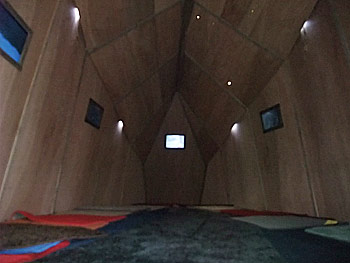
Kāinga a roto 5 screen installation, 2010
Museum Beelden aan Zee
The Hague, The Netherladns, Oct 2010 - Feb 2011
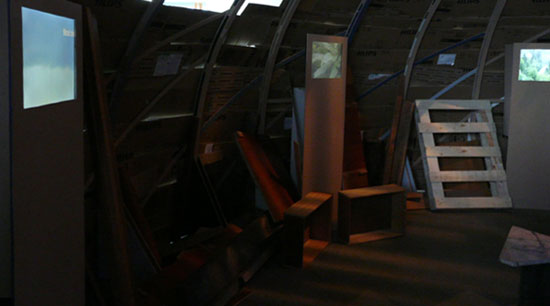
Kāinga a roto 5 screen installation, 2013, Puke Ariki
New Plymouth, Taranaki, Aotearoa | New Zealand
These days I regularly create video installations where video is incorporated into an architectural or sculptural setting such as the five screen work, Kāinga a roto(Home Within) which has been shown in three different settings so far.
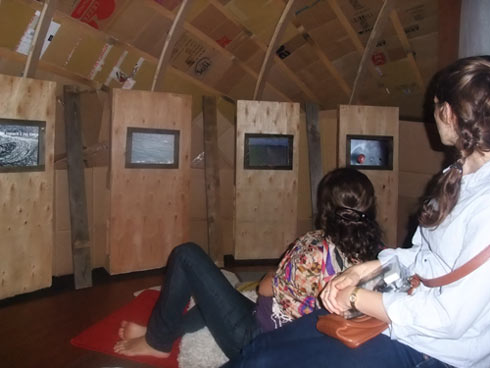
Kāinga a roto 5 screen installation, 2011
ISEA2011 Istanbul, Cumhuriyet Gallery, Taksim Square, Istanbul.
September 2011. Director: Lanfranco Aceti
See the Catalogue of the 17th International Symposium on Electronic Art
ISEA2011 Istanbul leoalmanac.org